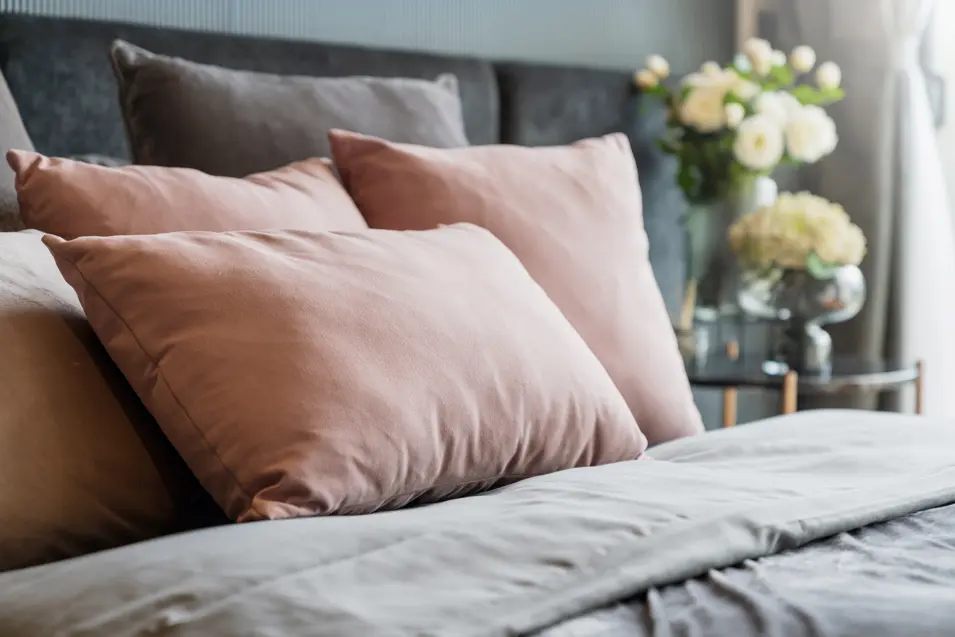There are some people who will tell you that pillows are more important than a mattress. While strictly speaking this isn’t true, a comfortable pillow (or four) can make the difference between a good night’s sleep and one you’d prefer to forget. Some people won’t even travel away from home unless they take their favorite pillow with them!
But like mattresses, pillows don’t last forever, and there will come a time when you’ll need to replace even your favorite ones. But how do you know when to replace your bedroom pillows?
The simple answer to this question is when they deteriorate—either in terms of form or shape, or when they start to get smelly. Sounds awful, but it happens! That said, there are many different types of pillows, mainly distinguished by their fillings, and some will last longer than others.
Pillows and Their Function
At its core, a pillow is simply a cloth bag filled with something soft to lay your head on while you sleep. However, its function goes beyond just comfort—it plays a crucial role in supporting your neck as you rest. Sure, it makes your head comfortable, but its real importance lies in neck support.
If you place your pillow (or pillows) at the top of the bed and sleep with your head tilted, you won’t be very comfortable and will probably wake up with an aching neck and shoulders. So, it’s essential to position your pillows in a way that provides the right support.
While some purists argue that it’s medically “correct” to sleep with one single, not-too-thick pillow, many people find they need more than one. Some like thick pillows, while others prefer thinner ones. Some enjoy bouncy pillows, while others opt for soft ones that their head can sink into. For instance, a person with broad shoulders who sleeps on their side will likely find it more comfortable to sleep with two pillows.
If you have certain preferences—like wanting to hug a pillow, having one behind your back, or needing to change pillows during the night to keep them cool (or warm)—you might end up with four pillows! But don’t try to stick them all under your head at once!
In general, back care experts recommend that instead of using a bunch of pillows to prop yourself up, it’s better to prop up your legs. This way, you ensure your spine, trunk, and head are aligned, allowing your muscles to relax. However, those who have trouble breathing may prefer to slightly elevate their heads.
Different Types of Pillows
Pillows are typically made from a strong outer cover filled with a variety of materials. They come in different sizes and the filling varies. Regardless of the filling, pillows require a removable pillowcase that can be washed.
The most common pillow fillings are:
- Feather and Down: Feather and down pillows are usually a mix of both, with the amount of feather versus down affecting the firmness. The more feathers there are, the firmer the pillow. However, the sharp ends of feathers can sometimes poke through the pillow casing. Over time, this can lead to the pillow losing bulk. Down, which comes from ducks and geese, is light and fluffy. Goose down is typically more expensive than duck down but both offer a soft, resilient pillow. A well-known maker of soft down pillows in North America is Lehmans (www.lehmans.com), a company rooted in the Amish community.
- Chicken Feathers: Purified and processed chicken feathers are a popular and affordable pillow filling, often used as a by-product of chicken farming.
- Organic Pillows: Eco-conscious organic pillows have grown in popularity. Fillings include organic cotton, buckwheat, wool, and kapok. Buckwheat pillows, for example, are made by small businesses like Buckwheat Glory, run by a dedicated craftsman from Pennsylvania.
- Polyester: While polyester fillings are synthetic and less eco-friendly, they are soft, non-allergenic, and easy to wash. However, polyester pillows can become lumpy and uncomfortable over time, despite being washable.
- Latex Foam: Derived from rubber trees, latex foam pillows are non-allergenic and germ-resistant. They are firmer and more springy than other pillows, though some people find them too rigid.
- Hop Pillows: Not commonly found today, hop pillows were once thought to have sleep-inducing properties. Dried hops were mixed with feathers or polyester and used as pillow stuffing. The lupulin in hops was believed to promote sleep.
- Traditional Japanese Pillows: Dried beans were traditionally used in Japanese pillows, although this method isn’t widely popular today.
Caring for Pillows
Taking good care of your pillows will extend their lifespan and reduce the frequency of replacements. Typically, you’ll know it’s time to discard a pillow when the filling deteriorates or when it becomes soiled or smelly. While a pillowcase can conceal some issues, it’s still important for hygiene reasons to replace your pillows regularly.
The care you provide will depend on the materials used in your pillow.
Down and Feather Pillows: These should not be washed but can be aired outside from time to time, preferably in the sun. If a feather or down pillow gets wet, squeeze out the liquid and spin dry it. Avoid using a tumble dryer.
Polyester Pillows: Usually washable, these pillows should not be dry-cleaned or placed in a tumble dryer.
Latex Foam Pillows: Can be cleaned by sponging. If they need washing, check the manufacturer’s instructions. Note that latex deteriorates when exposed to light, so avoid drying them in the sun. Instead, squeeze out excess moisture and let them dry in a dark, well-ventilated space.
Ultimately, the best answer to the question, “When should I replace my bedroom pillows?” is simple: replace them when they become uncomfortable or unhygienic.





